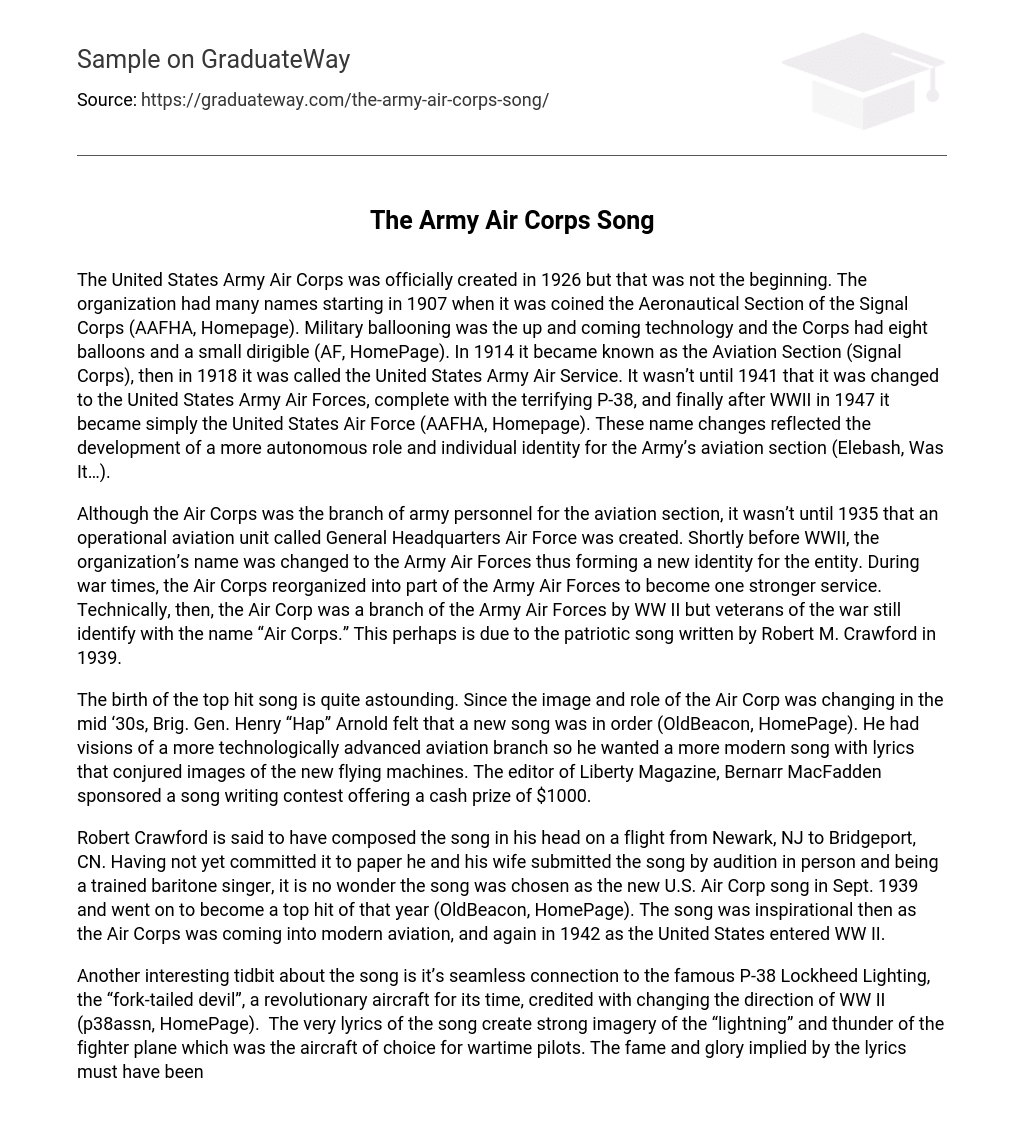The United States Army Air Corps was officially created in 1926 but that was not the beginning. The organization had many names starting in 1907 when it was coined the Aeronautical Section of the Signal Corps (AAFHA, Homepage). Military ballooning was the up and coming technology and the Corps had eight balloons and a small dirigible (AF, HomePage). In 1914 it became known as the Aviation Section (Signal Corps), then in 1918 it was called the United States Army Air Service. It wasn’t until 1941 that it was changed to the United States Army Air Forces, complete with the terrifying P-38, and finally after WWII in 1947 it became simply the United States Air Force (AAFHA, Homepage). These name changes reflected the development of a more autonomous role and individual identity for the Army’s aviation section (Elebash, Was It…).
Although the Air Corps was the branch of army personnel for the aviation section, it wasn’t until 1935 that an operational aviation unit called General Headquarters Air Force was created. Shortly before WWII, the organization’s name was changed to the Army Air Forces thus forming a new identity for the entity. During war times, the Air Corps reorganized into part of the Army Air Forces to become one stronger service. Technically, then, the Air Corp was a branch of the Army Air Forces by WW II but veterans of the war still identify with the name “Air Corps.” This perhaps is due to the patriotic song written by Robert M. Crawford in 1939.
The birth of the top hit song is quite astounding. Since the image and role of the Air Corp was changing in the mid ‘30s, Brig. Gen. Henry “Hap” Arnold felt that a new song was in order (OldBeacon, HomePage). He had visions of a more technologically advanced aviation branch so he wanted a more modern song with lyrics that conjured images of the new flying machines. The editor of Liberty Magazine, Bernarr MacFadden sponsored a song writing contest offering a cash prize of $1000.
Robert Crawford is said to have composed the song in his head on a flight from Newark, NJ to Bridgeport, CN. Having not yet committed it to paper he and his wife submitted the song by audition in person and being a trained baritone singer, it is no wonder the song was chosen as the new U.S. Air Corp song in Sept. 1939 and went on to become a top hit of that year (OldBeacon, HomePage). The song was inspirational then as the Air Corps was coming into modern aviation, and again in 1942 as the United States entered WW II.
Another interesting tidbit about the song is it’s seamless connection to the famous P-38 Lockheed Lighting, the “fork-tailed devil”, a revolutionary aircraft for its time, credited with changing the direction of WW II (p38assn, HomePage). The very lyrics of the song create strong imagery of the “lightning” and thunder of the fighter plane which was the aircraft of choice for wartime pilots. The fame and glory implied by the lyrics must have been a great impetus for enlistment. The number of enlistees grew from 26, 500 in 1939 to 2,253,000 in 1945 (af.mil, HomePage).
“Much of the history of the Air Force and other services is captured in songs that airmen and other troops have sung or hummed as they carried out their duties around the world” (Getz, Rhythm and Blue). The Army Air Corps Song is no exception.
Works Cited:
AAFHA.org. 18 March 2009, AAFHA.org. <http://www.aafha.org/aaf_or_aircorps.html>
AF.mil. 18 March 2009. AF.mil. <http://www.af.mil/history/overview.asp>
Elebash, C. C., “Was It the Air Corps or Army Air Forces in WW II?” AAFHA.org. 18 March 2009. AAFHA.org. <http://www.aafha.org/aaf_or_aircorps.html>
Getz, Bill. “Rhythm and Blue.” Buffalo State.edu. 18 March 2009. Faculty.buffalostate.edu. <http://faculty.buffalostate.edu/fishlm/articles/getz.pdf>
OldBeacon.com. 18 March 2009. OldBeacon.com. <http://www.oldbeacon.com/beacon/air_corps_song.htm>
P38assn.org. 18March 2009. <http://p38assn.org/>





